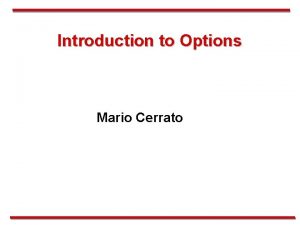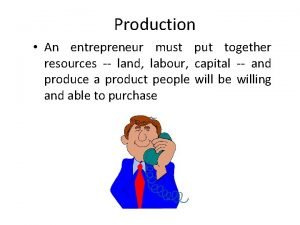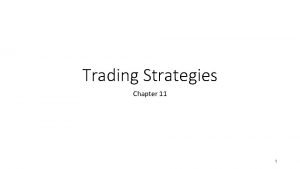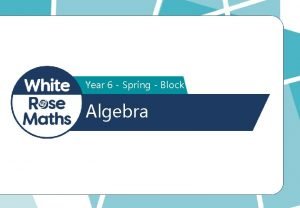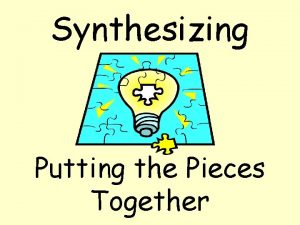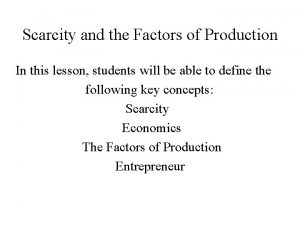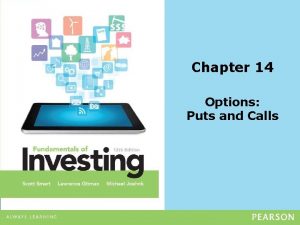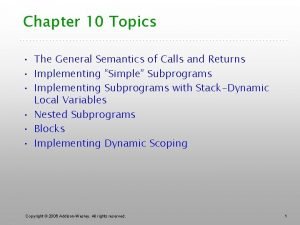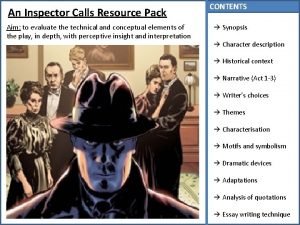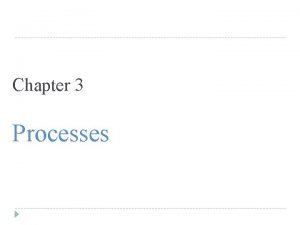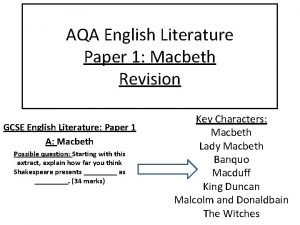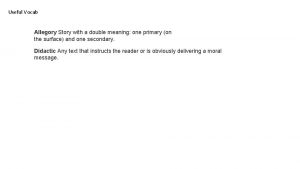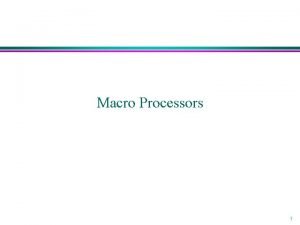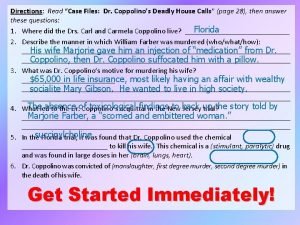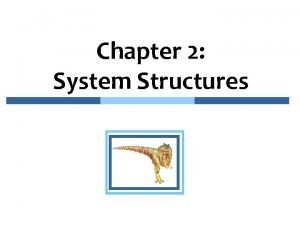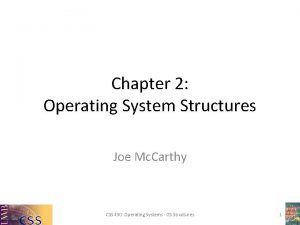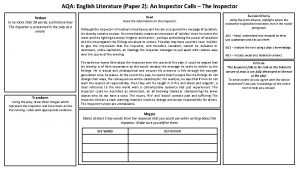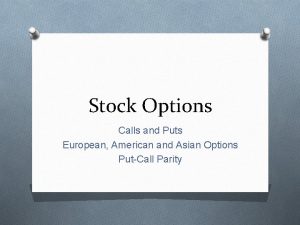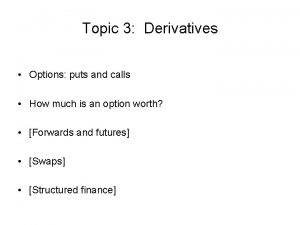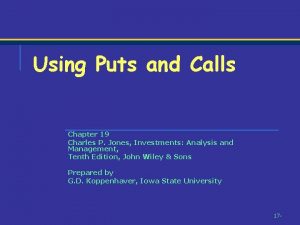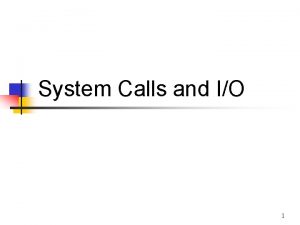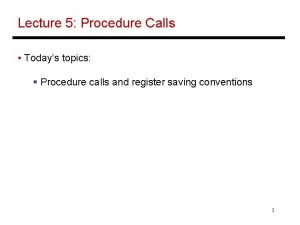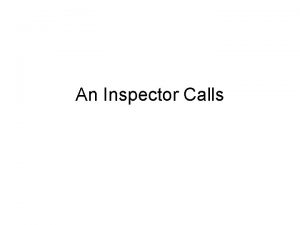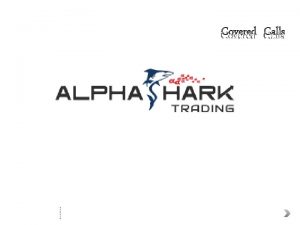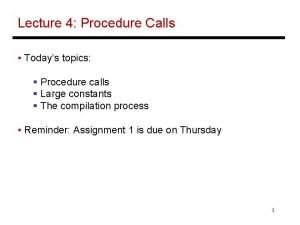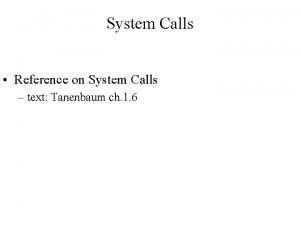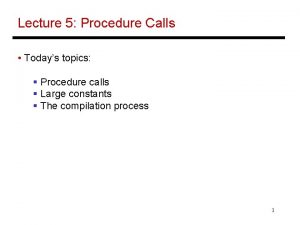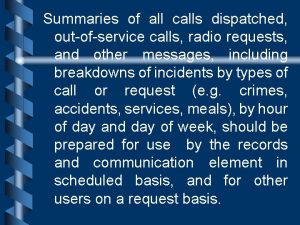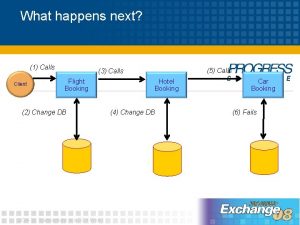Chapter 14 Options Puts and Calls Options Puts




































- Slides: 36

Chapter 14 Options: Puts and Calls

Options: Puts, Calls and Warrants • Financial Asset: asset that represents a financial claim on an issuing organization – Stocks, bonds and convertible securities are examples • Option: the right to buy or sell a certain amount of an underlying financial asset at a specified price for a given period of time Copyright © 2014 Pearson Education, Inc. All rights reserved. 14 -2

Types of Options • Types of Options – Puts – Calls – Rights – Warrants • All of the above are types of derivative securities, which derive their value from the price behavior of an underlying real or financial asset Copyright © 2014 Pearson Education, Inc. All rights reserved. 14 -3

Options: Puts and Calls • Puts and calls may be traded on: – Common stocks – Stock indexes – Exchange traded funds – Foreign currencies – Debt instruments – Commodities and financial futures • Owners of put and call options have no voting rights, no privileges of ownership, and no interest or dividend income Copyright © 2014 Pearson Education, Inc. All rights reserved. 14 -4

Options: Puts and Calls (cont’d) • Options allow buyers to use leverage; investors can benefit from stock-price movements without having to invest a lot of capital • A given percentage change in a stock’s price usually generates a larger percentage change in an option’s price • Puts and calls are created by individual investors, not by the organizations that issue the underlying financial asset Copyright © 2014 Pearson Education, Inc. All rights reserved. 14 -5

Options: Puts and Calls (cont’d) • Option Buyer – Has the right to buy (in the case of a call option) or sell (in the case of a put option) an underlying asset at a fixed price (called the exercise price or strike price) for a given period of time – To acquire this right, the option buyer must pay the option seller a fee known as the option premium (or option price) – Buyers do not have to exercise their options; they can walk away if exercising the option isn’t profitable Copyright © 2014 Pearson Education, Inc. All rights reserved. 14 -6

Options: Puts and Calls (cont’d) • Option Seller (also called the option writer) – Receives the option premium from the buyer up front – Has the obligation to sell (in the case of a call option) or buy (in the case of a put option) the underlying asset according to the terms of the option contract – Whereas option buyer can walk away if exercising the option is unprofitable, option seller cannot walk away Copyright © 2014 Pearson Education, Inc. All rights reserved. 14 -7

Options: Puts and Calls (cont’d) • Put and call options trade in the open market much like any other security and may be bought and sold through securities brokers and dealers • Values of puts and calls change with the values of the underlying assets • Other factors influence option prices (e. g. , an option’s value is usually higher if there is more time before the option expires) Copyright © 2014 Pearson Education, Inc. All rights reserved. 14 -8

Advantages of Puts and Calls • Allows use of leverage – Leverage: the ability to obtain a given equity position at a reduced capital investment, thereby magnifying total return • Option buyer’s potential loss is limited to fee paid to purchase the put or call option • Investors can make money when value of assets go up or down Copyright © 2014 Pearson Education, Inc. All rights reserved. 14 -9

Disadvantages of Puts and Calls • Investor does not receive any interest or dividend income • Options expire; the investor has limited time to benefit from options before they become worthless • Options are risky; a small change in the price of the underlying asset may make an option worthless • Option seller’s exposure to risk may be unlimited Copyright © 2014 Pearson Education, Inc. All rights reserved. 14 -10

How Calls Work • Call: an option that gives the holder (buyer) the right to buy the underlying security at a specified price over a set period of time – The buyer of the call option wants the price of the underlying asset to go up – The seller of the call option wants the price of the underlying asset to go down Copyright © 2014 Pearson Education, Inc. All rights reserved. 14 -11

How Calls Work (cont’d) • If the price of the underlying asset goes above the option’s strike price: – The option holder will purchase the asset at the strike price and then sell it at the higher market price, making a profit – The option writer must sell the asset at the strike price (which is lower than the asset’s market price). – If the seller does not already own the underlying asset, then the seller will have to purchase it at the higher market price • Covered call: seller owns the underlying asset • Naked call: seller does not own the underlying asset Copyright © 2014 Pearson Education, Inc. All rights reserved. 14 -12

How Calls Work (cont’d) • If the price of the underlying asset goes down: – The buyer will let the call option expire worthless and lose the option premium – The seller will keep the option premium and make a profit Copyright © 2014 Pearson Education, Inc. All rights reserved. 14 -13

How Calls Work (cont’d) • Example: Assume the market price for a share of common stock is $50. An investor buys a call option which grants the right to purchase 100 shares of the stock at a strike price of $50. The call premium is $500 • If the market price of the stock goes up to $75 per share, the investor will exercise the right to purchase 100 shares for $50. The investor then sells the shares on the open market for $75. • The investor’s net profit will be: • The option seller’s loss will be: • Notice that the buyer’s profit equals the seller’s loss; options are a zero-sum game Copyright © 2014 Pearson Education, Inc. All rights reserved. 14 -14

How Calls Work: The Value of Leverage • In the previous example, the option buyer makes a profit of $2, 000 after investing just $500 in capital • The buyer’s total return using the call option was: • Rather than buying the option, the investor might have simply purchased 100 shares of stock directly. At a price of $50 per share, the cost of 100 shares would have been $50, 000. If the share price had risen to $75, the investor would have earned a $2, 500 profit. The total rate of return on the investment would have been: • The same $25 increase in the stock price generates a much higher rate of return for the option investor than for an investor who buys stocks directly Copyright © 2014 Pearson Education, Inc. All rights reserved. 14 -15

How Calls Work (cont’d) • Example: Assume the market price for a share of common stock is $50. An investor buys a call option to purchase 100 shares of the stock at a strike price of $50 per share. The option premium is $500. • If the market price of the stock goes down to $25 per share, the investor will allow the call option to expire worthless. • The option buyer’s loss will be: • The option seller’s profit will be equal to the option premium: Copyright © 2014 Pearson Education, Inc. All rights reserved. 14 -16

How Puts Work • Put: an option that enables the holder (buyer) to sell the underlying security at a specified price over a set period of time – The buyer of the put option wants the price of the underlying asset to go down – The seller of the put option wants the price of the underlying asset to go up Copyright © 2014 Pearson Education, Inc. All rights reserved. 14 -17

How Puts Work (cont’d) • If the price of the underlying asset goes below the put option’s strike price: – The put owner will buy the underlying asset, paying the open-market price, and then force the put seller to buy the asset at the higher strike price, making a profit – The seller will pay a price higher than the market price • If the price of the underlying asset goes up: – The buyer will let the put option expire worthless and lose the option premium – The seller will keep the option premium and make a profit Copyright © 2014 Pearson Education, Inc. All rights reserved. 14 -18

How Puts Work (cont’d) • Example: Assume the market price for a share of common stock is $50. An investor buys a put option that grants the right to sell 100 shares of the stock at a strike price of $50. The option premium is $500. • If the market price of the stock goes down to $25 per share, the investor will purchase 100 shares of stock in the open market for $25 each. Then the investor exercises his right to sell those shares to the put seller for $50 each • The buyer of the put option earns a profit of $2, 000: • The seller’s loss will be: Copyright © 2014 Pearson Education, Inc. All rights reserved. 14 -19

How Puts Work (cont’d) • Example: Assume the market price for a share of common stock is $50. A put option to sell 100 shares of the stock at a strike price of $50 per share may be purchased for $500. • If the market price of the stock goes up to $75 per share, the buyer will allow the put option to expire worthless. • The buyer’s loss will be: • The seller/maker/writer’s profit will be: Copyright © 2014 Pearson Education, Inc. All rights reserved. 14 -20

Put and Call Options Markets • Conventional (OTC) Options – Sold over the counter – Primarily used by institutional investors • Listed Options – Created in 1973 by the Chicago Board Option Exchange (CBOE) – Puts and calls traded through CBOE exchange, as well as International Securities Exchange, AMEX, Philadelphia exchange, NYSE Arca and Boston Options Exchange. – Provided convenient market that made options trading more popular and help create a secondary market – Helped standardize expiration dates and exercise/strike prices – Reduced trading costs Copyright © 2014 Pearson Education, Inc. All rights reserved. 14 -21

Stock Options • Common Stock Options – Several billion option contracts are traded each year – Options on common stocks are the most popular form of option – Over 90% of all option contracts are stock options Copyright © 2014 Pearson Education, Inc. All rights reserved. 14 -22

Key Provisions of Stock Options • Strike Price – Stated price at which you can buy a security with a call or sell a security with a put – Conventional (OTC) options may have any strike price – Listed options have standardized prices with price increments determined by the price of the stock • Expiration Date – Stated date when the option expires and becomes worthless if not exercised – Conventional (OTC) options may have any working day as expiration date – Listed options have standardized expiration dates Copyright © 2014 Pearson Education, Inc. All rights reserved. 14 -23

Figure 14. 1 Quotations for Listed Stock Options Source: quotemedia. com, accessed August 8, 2012. Copyright © 2014 Pearson Education, Inc. All rights reserved. 14 -24

Expiration Date of Listed Stock Options • Three Expiration Cycles – The January/April/July/October cycle – The February/May/August/November cycle – The March/June/September/December cycle • The longest-term expiration dates are normally no longer than nine months • The options that are longer than nine months are called LEAPS, and they are only available on some of the stocks • Listed options always expire on the third Friday of the month of expiration Copyright © 2014 Pearson Education, Inc. All rights reserved. 14 -25

Valuation of Stock Options • Option Premium (Price): the quoted price the investor pays to buy a listed put or call option • Option premiums (prices) are affected by: – Intrinsic value: based upon current market price of underlying assets – Time Premium: amount that option price exceeds the fundamental value Copyright © 2014 Pearson Education, Inc. All rights reserved. 14 -26

Intrinsic Value of a Call Option • The intrinsic value of a call option equals the difference between the market price of the stock and the strike price of the option, or zero, whichever is greater • Example: Suppose a call option has a strike price of $50 – If the underlying stock price is $75, the call’s intrinsic value is $25 (actually, $2, 500 because the call grants the right to buy 100 shares) – If the underlying stock price is $25, the call’s intrinsic value is $0 Copyright © 2014 Pearson Education, Inc. All rights reserved. 14 -27

Intrinsic Value of a Put Option • The intrinsic value of a put option equals the difference between the strike price of the option and the market price of the stock, or zero, whichever is greater • Example: Suppose a put option has a strike price of $50 – If the underlying stock price is $25, the put’s intrinsic value is $25 (actually $2, 500 because the put grants the right to sell 100 shares) – If the underlying stock price is $75, the put’s intrinsic value is $0 Copyright © 2014 Pearson Education, Inc. All rights reserved. 14 -28

Figure 14. 2 The Valuation Properties of Put and Call Options Copyright © 2014 Pearson Education, Inc. All rights reserved. 14 -29

Valuation of Stock Options • In-the-Money – Call option: when the strike price is less than the market price of the underlying security – Put option: when the strike price is greater than the market price of the underlying security – When an option is in the money, its intrinsic value is greater than zero • Out-of-the-Money – Call option: when the strike price is greater than the market price of the underlying security – Put option: when the strike price is less than the market price of the underlying security Copyright © 2014 Pearson Education, Inc. All rights reserved. 14 -30

Option Pricing Models • The best known option pricing model is the Black and Scholes Model • The model states that an option’s price depends on five variables – The – The option’s strike price option’s expiration date price of the stock risk free rate of interest stock’s volatility Copyright © 2014 Pearson Education, Inc. All rights reserved. 14 -31

Option Trading Strategies • Buying for Speculation • Hedging to modify risks • Writing Options to enhance returns • Spreading Options to enhance returns Copyright © 2014 Pearson Education, Inc. All rights reserved. 14 -32

Stock-Index Options • Stock-Index Option: a put or call option written on a specific stock market index • Major stock indexes for options: – The S&P 500 Index S&P 100 Index Dow Jones Industrial Average Nasdaq 100 Index Copyright © 2014 Pearson Education, Inc. All rights reserved. 14 -33

Stock-Index Options (cont’d) • Market price is function of strike price of option and latest published stock market index value • Valuation techniques are similar to valuing options for individual securities • Price behavior and investment risk are similar to options for individual securities • May be used to hedge a whole portfolio of stocks rather than individual stocks • May be used to speculate on the stock market as a whole Copyright © 2014 Pearson Education, Inc. All rights reserved. 14 -34

Other Types of Options • Exchange traded funds: put and call options written on exchange traded funds (EFT’s) – Very similar to market index options • Interest rate options: put and call options written on fixed-income (debt) securities – Small market involving only U. S. Treasury securities – Option prices change with yield behavior of debt securities Copyright © 2014 Pearson Education, Inc. All rights reserved. 14 -35

Other Types of Options (cont’d) • Currency options: put and call options written on foreign currencies – Available on most major world currencies – Option prices change as exchange rates between currencies fluctuate • LEAPS: long-term options that may extend out to 3 years – Available on several hundred stocks and over two dozen stock indexes and ETF’s Copyright © 2014 Pearson Education, Inc. All rights reserved. 14 -36
 Definition of calls and puts
Definition of calls and puts Difference between string and array
Difference between string and array Differentiate between gets() and puts()
Differentiate between gets() and puts() Who puts together land , labour and capital for production
Who puts together land , labour and capital for production A monster calls chapter 17
A monster calls chapter 17 Bear spread using puts
Bear spread using puts Protective put
Protective put Rima puts the tub in the sun
Rima puts the tub in the sun Function machines maths
Function machines maths Together
Together The official nordstrom organization chart puts the
The official nordstrom organization chart puts the Cara penggunaan puts
Cara penggunaan puts Who is a person who puts together land
Who is a person who puts together land The official nordstrom organization chart puts the
The official nordstrom organization chart puts the Templates for explaining quotations
Templates for explaining quotations Putts and calls
Putts and calls General semantics of calls and returns
General semantics of calls and returns Socialism and capitalism in an inspector calls bbc bitesize
Socialism and capitalism in an inspector calls bbc bitesize Follow the drinking gourd lyrics
Follow the drinking gourd lyrics Fork() wait() exec() and exit() system calls
Fork() wait() exec() and exit() system calls Paper 1 literature aqa
Paper 1 literature aqa When the sun comes back and the first quail calls
When the sun comes back and the first quail calls Chapter 3 food service career options worksheet answers
Chapter 3 food service career options worksheet answers Sheila birling
Sheila birling An inspector calls generation gap
An inspector calls generation gap It is a repetitive process in which algorithm calls itself.
It is a repetitive process in which algorithm calls itself. Script for recruiter cold call
Script for recruiter cold call Rocket sweep playbook
Rocket sweep playbook Nested macro calls in system software
Nested macro calls in system software Dr coppolino deadly house calls
Dr coppolino deadly house calls Tacoma fire department calls
Tacoma fire department calls Gerald croft character traits
Gerald croft character traits Layered structure in os
Layered structure in os Device management system calls
Device management system calls Literature paper 2 inspector calls
Literature paper 2 inspector calls Miners strike 1912
Miners strike 1912 Inspector calls quotes
Inspector calls quotes
